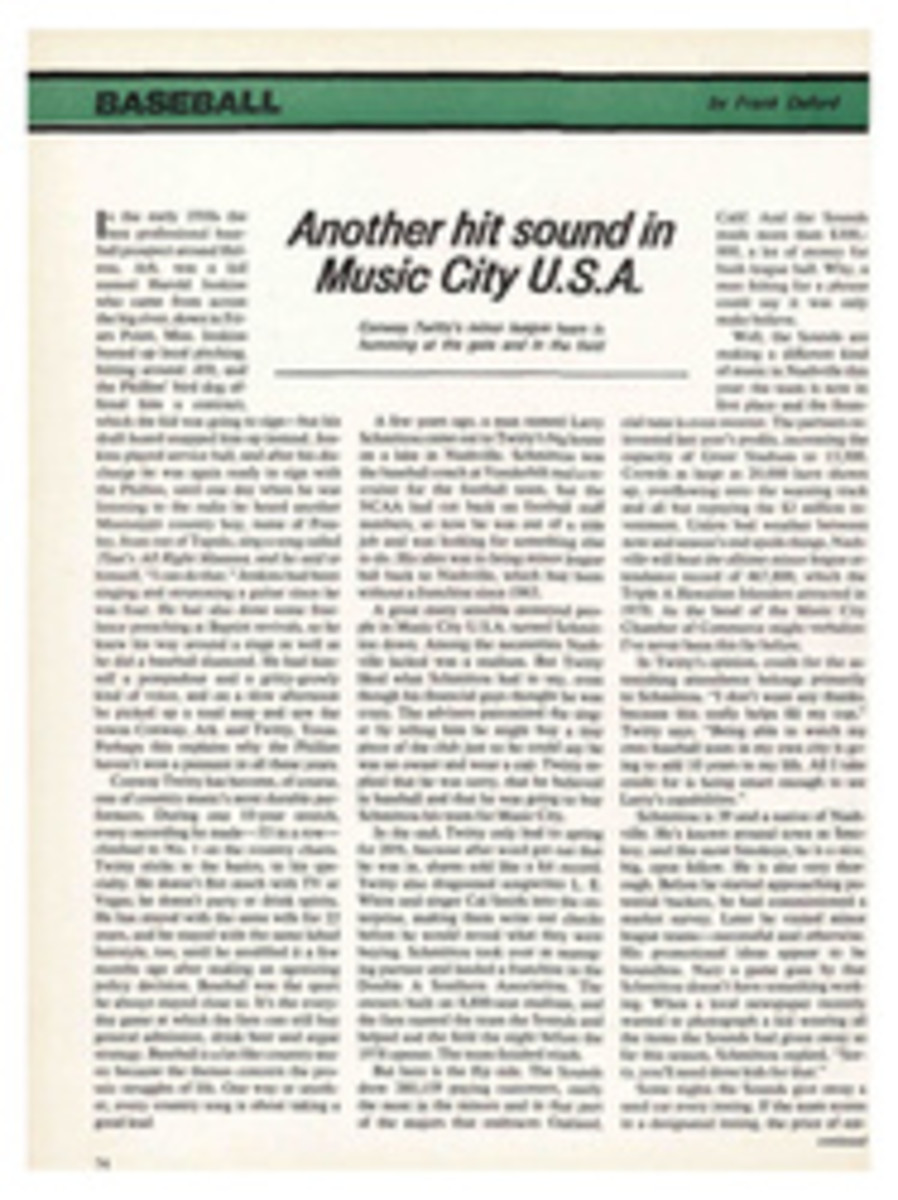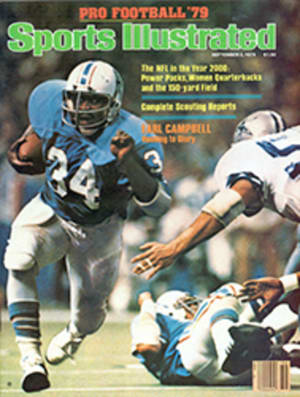
He's got a very fishy look
The sign at the precipitous edge of the Black Canyon of the Yellowstone River warned that this was grizzly-bear country. It was also Friday the 13th, but Charles E. Brooks, former secret agent turned angling writer, paid no heed. "Come on," he said. "Those salmonflies are hatching down there." When a companion asked what they would do if they ran into a grizzly, Brooks, a bear of a man himself, said, "I'll sing. They don't like noise."
Five hours and seven miles later, Brooks clambered out of the canyon. There had been no grizzlies, but plenty of plump cutthroat and rainbow trout, all released. Brooks had gone down into the canyon because he was interested in checking on the salmonfly hatch and seeing what his fur-and-hackle imitation of the adult would do. It outfished all the other ties. Salmonflies, as they are called in Montana, are actually huge stone flies, insects that grow to two inches in length, and Brooks has been studying them for years. Indeed, ever since he retired as an Air Force major in 1964, he has been examining almost everything that creeps, crawls, swims or flies in the trout country of southwestern Montana in an effort to make himself a better fisherman. As a friend once put it, "Charlie's trying to climb into a trout's head."
Brooks' books, notably Larger Trout for the Western Fly Fisherman, The Trout and the Stream and Nymph Fishing for Larger Trout, have won him a growing reputation. His style is clear, direct and without pretense, and his works are packed with telling detail gleaned not only from scientific studies but also from the thousands of hours he has spent creeping, crawling and swimming—often underwater—to get a trout's or salmonfly's view of the world.
Brooks, now 60, is not a trout fisherman to the fly rod born. He was a hillbilly raised in the Missouri Ozarks during the depths of the Depression. His father was badly hurt in an industrial accident in 1929, and the family, which included his mother and six brothers and sisters, lived in a succession of shacks. The Brookses kept body and soul together by chopping cotton. When Charlie was nine, he traded a bagful of deer tails to a local flytier for $2.50 in cash, a big box of materials, 100 hooks and an hour-and-a-half lesson in tying—"the greatest bargain I ever made in my life." Fishing the Current River with his own flies, cane pole, chalk line doused with linseed oil and horsehair leaders, Brooks "caught fish like nobody's business, and they were always welcome at home because we ate everything."
After he graduated from grammar school in 1933, Brooks became a migrant farm worker. He sent all his wages home to support his family, except for the 5¬¨¬®¬¨¢ a day he kept to buy bread and buttermilk. "I had that for supper," he says. "The farmers usually provided some kind of dinner, and I never did eat breakfast until I was 25 or 26."
After his father died in 1936, Brooks joined the Civilian Conservation Corps and worked in the West. Impressed by the trout streams of Montana and Wyoming, he promised himself he would live there one day and write about fishing. Eager for a high school education, he left the CCC in 1939 when the football coach of the high school team in Milan, Mo. promised him a job if he would play. Brooks was the outstanding defensive player in the history of the school, led the conference in punting and scoring, and also lettered in baseball, basketball and track. He completed high school in three years with a straight-A average. All the while, he held down two jobs, rising at five in the morning and going to bed at 11 each night. The first month he was there, several teachers complained about his whistling and singing in the halls, and when a teacher asked him why he did it, he said, "I'm so happy to be here. But I'll stop. I can be just as happy inside."
In 1942, Brooks joined the Army Air Corps as an aviation cadet. In time he was commissioned as a bombardier. He flew 50 missions over Europe. His pilot, Richard Witkin, now transportation reporter for The New York Times, says, "Charlie's the only man I ever met in my life who enjoyed war. I don't mean he liked to kill people, but when I was going through flak and enemy fighters, I was scared witless. To Charlie it was a thrill. To him, flak and enemy fighters were exciting. He's the last of the great adventurers."
Released from active duty in 1945, Brooks got temporary work as a park ranger at Yosemite but was turned down for a regular job because he lacked a college degree. He thought of going to Stanford, but felt he couldn't learn any more there than he could from books or life. By now married, and knowing he wanted to write, Brooks decided that the best thing he could do was to reenlist in the Air Force, put in his 20 years and then retire to explore and write.
Brooks was assigned to counterintelligence. One of his favorite assignments turned out to be scouting possible invasion sites of the Alaskan coast. He quickly discovered that the tide went out too far to allow an amphibious landing, but his superiors were slow in digesting this information, so he spent several months fishing trout and salmon streams in the cover guise of a wealthy sportsman. When Brooks left the Air Force for good in 1964, he and his wife, Grace, lit out for West Yellowstone, where they built a house.
Brooks soon began his research in Montana by observing the nymphs and larvae of insects that serve as food for trout in the Firehole, Gibbon and Madison rivers. "My aim is to fish the nymph imitation at the right place with the right motion," he says. "I wanted to find out what nymphs were in the water, and what action I should impart to the imitation." In one 100-yard stretch of the Madison, he observed Mayfly nymphs of the species Siphlonurus occidentalis, the gray drake, as it is known to anglers. "I found that the gray drake has to have a silt bottom around weeds, a current speed of not more than 1¾ miles per hour and a depth of about 20 inches," he says. "The nymph is slow-moving and clambers around weeds. It moves about in the early morning or late afternoon. It doesn't like bright sunlight." While Grace fished an imitation gray drake nymph so that it either swam along the bottom or seemingly climbed the weeds, Brooks watched the reaction of the trout underwater. As a result of this type of investigation, Brooks ties his nymph imitations without a wing case on the back so that if it should be turned over by the current, a fish won't wonder why it's upside down. "A live nymph never turns upside down in the water," he says. "A nymph imitation has to have color and form and life, and the more signs of life, the better." The ultimate in life simulation is Brooks' imitation of any of a number of large dragonfly nymphs. It is basically a one-eighth-inch-wide strip of natural brown seal fur, left on the skin, wrapped around the hook shank. In the water it pumps and breathes enticingly. "It's a rough, scraggly fly, but so is the natural," says Brooks.
To study the nymph of the giant salmonfly, Pteronarcys californica, he spent time down in Hole No. 2 of the Madison, breathing through a shower hose. "I found that the Pteronarcys nymphs feed twice every 24 hours," Brooks says. "I'd see them come out from under the rocks where they live to feed on algae on top of the rocks. First the smaller nymphs would come out, then the bigger ones and, finally, the biggest. The fish weren't interested until all the rocks were covered with nymphs of all sizes. Then I tried to find out why the nymphs were feeding when they did. I finally pinned it on temperature. In the summer they like to feed at 58° and generally knock off when it reaches 62°. In the fall, when the water cools, 52° will bring them out to feed."
At times, when a nymph would get washed away from the rocks by the current, a trout would glom on to it. To simulate the nymph in the current, Brooks began fishing what is now known as the Brooks Method. Using a short leader and a high-density sinking-belly line, he casts way upstream and, holding his arms high, allows the nymph to bounce along the bottom in a dead drift.
One autumn several years ago, when the well-known dry-fly fisherman Art Flick visited Brooks to fish the Madison, a cold snap hit. Brooks took the water temperature. It was 46°, and he announced that the fishing wouldn't be good until about 11:30 a.m. Meanwhile he would show Flick how to fish the heavy water with the Brooks Method. Flick got a few strikes, but Brooks explained that these were smaller fish that always began feeding before the bigger fish, in much the same way that the small Pteronarcys nymphs began feeding before the bigger ones did.
At 11:30 Brooks took the temperature, found it was 52° and told Flick the trout would start hitting. They did, right on schedule.
Brooks has been active as the permanent secretary of the Southwestern Montana Fly Fishers, a club he helped found in 1969. Though it has never had more than 24 members, its accomplishments are noteworthy. Its sole objective is to protect, maintain and improve the trout streams of the region. Among the club's achievements: putting an end to the stocking of hatchery trout of catch-able size in streams with naturally producing populations. "When you dump thousands of living units into any area not totally a desert or wilderness, you create an immediate shortage of shelter, and you create an intolerable sociological pressure on those biological units already there," Brooks says. "It does not matter whether we are talking of fish, rats, monkeys or humans. The result is precisely the same: chaos."
Public support for the Southwestern Montana Fly Fishers' goals has become significant. Indeed, last year's closing of the middle Madison to fishing for an undetermined period so that biologists can study the stream won wide public approval. "The swing is our way," says Brooks. "The people here see that they can prosper because people come from all over the country, even the world, to find what they don't have at home, quality fishing in an unspoiled environment." Then he adds, "My energies in life are expended on a narrow plane. I'm involved in studying, writing about, protecting and improving the ecology of trout streams in southwestern Montana. That's it. I'm not out to save the whole world. People who are out to save the whole world don't save anything. But I can say with certainty that the trout fishing we've got, as good as it is, is going to improve even more."
PHOTO
Wading in his beloved Madison, Brooks casts for trout.
PHOTO
Following his underwater observations, Brooks ties a giant salmonfly nymph with fur and hackle.

